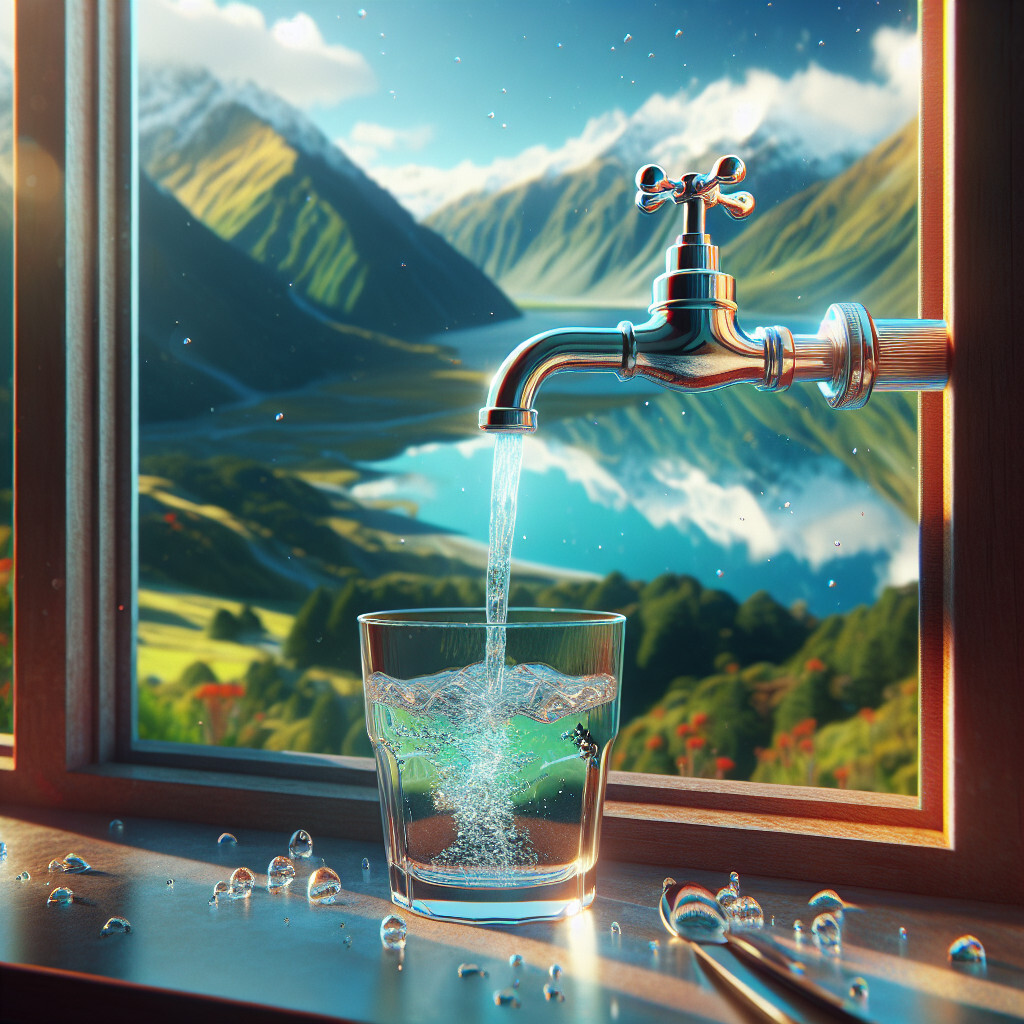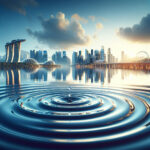-
Table of Contents
“New Zealand’s Tap Water: Pure, Clean, and Refreshingly Natural.”
Introduction

The tap water in New Zealand is generally of high quality and safe to drink. The country’s water supply is managed by local authorities who ensure it meets the standards set by the Ministry of Health. The water sources include rivers, lakes, and underground aquifers, which are typically clean due to the country’s low population density and strict environmental regulations. However, the quality can vary between regions and in some rural areas, residents may rely on rainwater collection or local water delivery services.
Understanding the Quality of Tap Water in New Zealand
New Zealand, a country known for its pristine landscapes and commitment to environmental sustainability, is also recognized for the quality of its tap water. The tap water in New Zealand is generally safe to drink and is subject to stringent quality controls. However, the quality can vary depending on the source of the water and the treatment processes it undergoes.
The primary sources of tap water in New Zealand are surface water, such as rivers and lakes, and groundwater from wells and springs. Surface water is more susceptible to contamination from human activities and natural processes, while groundwater is typically cleaner but can still be affected by pollutants. Regardless of the source, all tap water in New Zealand must meet the standards set by the Drinking-Water Standards for New Zealand (DWSNZ), which are based on guidelines from the World Health Organization.
The DWSNZ specifies maximum allowable levels for various contaminants, including bacteria, viruses, chemicals, and heavy metals. Water suppliers are required to regularly test their water for these contaminants and take corrective action if the levels exceed the standards. This ensures that the tap water is safe to drink and does not pose a risk to public health.
However, despite these stringent standards, there have been instances where the tap water in certain areas of New Zealand has been found to be contaminated. For example, in 2016, the town of Havelock North experienced a major waterborne disease outbreak due to contaminated tap water, which affected more than 5,000 people. This incident highlighted the potential risks associated with drinking tap water and led to a review of the country’s water management practices.
In response to this incident, the government of New Zealand has taken steps to further improve the quality of tap water. These include strengthening the DWSNZ, increasing the frequency of water testing, and investing in infrastructure to better treat and distribute water. The government has also launched a reform program to improve the management of three waters (drinking water, wastewater, and stormwater) and ensure the long-term sustainability of water resources.
Despite these efforts, it is important for consumers to be aware that the quality of tap water can still vary depending on the location. For instance, in some rural areas, the tap water may have a noticeable taste or odor due to the presence of natural minerals or organic matter. While this does not necessarily mean that the water is unsafe to drink, it may be less appealing to some people.
In conclusion, the tap water in New Zealand is generally of high quality and safe to drink, thanks to the country’s stringent water standards and commitment to environmental sustainability. However, the quality can vary depending on the source of the water and the treatment processes it undergoes. Therefore, it is advisable for consumers to stay informed about the quality of their local tap water and take appropriate precautions if necessary.
The Process of Water Treatment in New Zealand: Ensuring Safe Tap Water
New Zealand, a country known for its pristine landscapes and commitment to environmental sustainability, is also recognized for its high-quality tap water. The process of water treatment in New Zealand is a meticulous one, ensuring that the tap water is not only safe to drink but also meets the highest international standards.
The journey of water from source to tap in New Zealand is a fascinating one. It begins with the collection of water from various sources such as rivers, lakes, and underground aquifers. This raw water is then transported to treatment plants where it undergoes a series of rigorous purification processes. The first step in this process is coagulation and flocculation, where chemicals are added to the water to bind together the small particles of dirt and other impurities, forming larger particles called ‘flocs’.
Following this, the water is subjected to a process called sedimentation. Here, the flocs settle to the bottom of the water supply due to their increased weight, allowing for easy removal. The water then undergoes filtration, where it is passed through layers of sand, gravel, and charcoal to remove any remaining particles.
The final step in the treatment process is disinfection. This is a crucial stage where harmful bacteria and viruses are eliminated to ensure the water is safe for consumption. In New Zealand, chlorine is commonly used for this purpose. However, some regions also use ultraviolet light or ozone, both of which are highly effective at killing microorganisms.
Once the water has been treated, it is stored in clean, covered reservoirs before being distributed to homes and businesses through an extensive network of pipes. Regular testing is conducted throughout this process to ensure the water remains free from harmful contaminants and meets the stringent quality standards set by the New Zealand Drinking Water Standards.
The quality of tap water in New Zealand is a testament to the country’s commitment to public health and environmental sustainability. The government invests heavily in water infrastructure and treatment technologies to ensure the tap water is of the highest quality. Moreover, the country’s strict regulations and rigorous testing protocols ensure that any potential issues are quickly identified and addressed.
However, it’s important to note that while the tap water in most parts of New Zealand is safe to drink, there can be variations in quality in some regions. Factors such as natural disasters, agricultural runoff, and aging infrastructure can sometimes impact the quality of the water. Therefore, it’s always a good idea to check with local authorities or your accommodation provider if you’re unsure about the safety of the tap water in a particular area.
In conclusion, the tap water in New Zealand is generally of high quality, thanks to the country’s rigorous water treatment processes and strict quality standards. Whether you’re a resident or a visitor, you can usually drink the tap water with confidence, knowing that it has undergone a meticulous process to ensure its safety and purity. However, it’s always wise to stay informed about the local water quality, particularly in areas prone to natural disasters or with older infrastructure.
Health Implications of Drinking Tap Water in New Zealand
New Zealand, a country known for its pristine landscapes and high environmental standards, is often assumed to have tap water of exceptional quality. However, the reality of the situation is more complex and warrants a closer examination, particularly in terms of the health implications of drinking tap water in New Zealand.
Firstly, it is important to note that the quality of tap water can vary significantly across different regions of New Zealand. In some areas, the tap water is sourced from rivers and lakes, while in others, it comes from groundwater. The source of the water can have a significant impact on its quality, as surface water is more likely to be contaminated with pollutants and pathogens, while groundwater is typically cleaner but can contain harmful minerals.
In terms of chemical contaminants, New Zealand’s tap water is generally considered safe. The country has strict regulations in place to limit the levels of chemicals such as chlorine, fluoride, and lead in drinking water. However, there have been instances where these limits have been exceeded. For example, in 2016, the town of Havelock North experienced a major water contamination incident, where over 5,000 people fell ill due to the presence of Campylobacter bacteria in the town’s drinking water supply. This incident highlighted the potential risks associated with drinking tap water in New Zealand, even though such events are relatively rare.
On the other hand, the presence of certain minerals in New Zealand’s tap water can actually have health benefits. For instance, fluoride, which is added to the water supply in many parts of the country, can help to prevent tooth decay. Similarly, the naturally occurring calcium and magnesium in the water can contribute to a healthy diet.
However, it is also worth noting that the taste and smell of the tap water can vary across different regions of New Zealand, due to the different treatment processes and sources of water. While this does not necessarily indicate a health risk, it can affect people’s perception of the water’s quality and their willingness to drink it.
In conclusion, while the tap water in New Zealand is generally safe to drink, there are potential health implications that need to be considered. The quality of the water can vary across different regions, and there have been instances of contamination. Therefore, it is recommended that individuals, particularly those with weakened immune systems or specific health concerns, consider using a water filter or drinking bottled water.
Furthermore, it is crucial for the government and water suppliers to continue monitoring and improving the quality of the tap water, to ensure that it remains safe for all residents and visitors. This includes regular testing for contaminants, investing in water treatment facilities, and educating the public about the importance of water quality.
In the end, the health implications of drinking tap water in New Zealand are a complex issue that requires ongoing attention and action. However, with the right measures in place, the country’s tap water can continue to be a safe and healthy choice for most people.
Environmental Impact of New Zealand’s Tap Water Management
New Zealand, a country known for its pristine landscapes and commitment to environmental sustainability, has a unique approach to managing its tap water. The environmental impact of New Zealand’s tap water management is a topic of interest for many, as it reflects the country’s dedication to preserving its natural resources and maintaining a high standard of public health.
The tap water in New Zealand is primarily sourced from rivers, lakes, and underground aquifers. These sources are abundant due to the country’s high rainfall and low population density. However, the quality of the water can vary depending on the source and the region. In urban areas, tap water is typically treated and filtered to remove any impurities, while in rural areas, residents may rely on untreated water from wells or springs. Despite these differences, New Zealand’s tap water is generally considered safe to drink, with strict regulations in place to ensure its quality.
The management of tap water in New Zealand is closely linked to the country’s environmental policies. The government has implemented a range of measures to protect water sources and reduce the impact of human activities on water quality. These include restrictions on land use near water bodies, regulations on the discharge of pollutants, and programs to promote water conservation.
One of the key aspects of New Zealand’s tap water management is its focus on sustainability. The country has a comprehensive water management strategy that aims to balance the needs of people and the environment. This involves careful planning to ensure that water is used efficiently and that supplies are maintained for future generations. The strategy also includes measures to protect and restore water ecosystems, recognizing their importance for biodiversity and the overall health of the environment.
In addition to these measures, New Zealand has also invested in advanced water treatment technologies. These technologies not only improve the quality of tap water but also reduce the environmental impact of water treatment processes. For example, some treatment plants in New Zealand use biological processes to remove pollutants from water, which is more environmentally friendly than traditional chemical treatments.
However, despite these efforts, there are still challenges to managing the environmental impact of tap water in New Zealand. Climate change is a major concern, as it can lead to changes in rainfall patterns and increase the risk of droughts, which can affect water supplies. There are also issues related to agricultural pollution, as farming activities can lead to the contamination of water sources with nutrients and other pollutants.
In response to these challenges, the government of New Zealand is continually reviewing and updating its water management policies. This includes investing in research to understand the impacts of climate change on water resources and developing strategies to mitigate these impacts. The government is also working with farmers and other stakeholders to promote sustainable farming practices and reduce the impact of agriculture on water quality.
In conclusion, the environmental impact of New Zealand’s tap water management is a reflection of the country’s commitment to sustainability and environmental protection. While there are challenges to be faced, the country’s comprehensive approach to water management, combined with its investment in advanced treatment technologies and ongoing policy review, ensures that its tap water remains safe to drink and its water resources are protected for future generations.
Q&A
1. Question: Is the tap water in New Zealand safe to drink?
Answer: Yes, the tap water in most parts of New Zealand is safe to drink.
2. Question: What is the quality of tap water in New Zealand?
Answer: New Zealand’s tap water is generally of high quality, meeting or exceeding international standards.
3. Question: Are there any areas in New Zealand where tap water is not safe to drink?
Answer: In some remote areas and small communities, tap water may not meet the same standards as in urban areas, so it’s recommended to check local advice.
4. Question: Does the tap water in New Zealand contain any harmful substances?
Answer: The tap water in New Zealand is regularly tested and does not typically contain harmful levels of substances. However, in some areas, it may contain natural minerals like fluoride.
Conclusion
The tap water in New Zealand is generally of high quality and safe to drink, with strict standards and regular testing in place to ensure its cleanliness and safety. However, the quality can vary depending on the region and source of the water.






